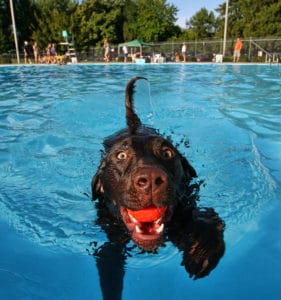
Black Labrador Retriever. Photo: Isabela Kronemberger/Unsplash.com
Labrador Retriever breed profile
Classification
The Labrador Retriever is classed as Group 3 (Gundogs) by the Australian National Kennel Council (ANKC).
The Labrador Retriever also commonly called Labradors or Labs, is one of six kinds of retrievers. The other retriever breeds are Golden Retriever, Flat Coated Retriever, Curly Coated Retriever, Chesapeake Bay Retriever and Nova Scotia Duck Tolling Retriever.
History
The Labrador Retriever was bred primarily as a working retrieving gundog. Labrador Retrievers were originally found, not in Labrador, but in Newfoundland, where they were used in many capacities by cod fisherman.
With their short but exceptionally dense coat, they were well suited to the cope with the freezing salt spray, snowy and icy near-Arctic winds, and with their willingness to help and please which persists to this day, they have been the most useful helpers.
They were expected to retrieve the fish that slipped out of the net and flapped on the icy surface of the sea. They had to carry the rope end from the boat to the shore in the strongest of tides and stormiest weather. They were strongly built so that they could pull a heavy sled carrying firewood, barrels of fish, and other necessities of life in a place where horses would be useless.
In the early 1880’s, in the north of England, a few landowners mated together with a handful of Labradors that had survived from an earlier importation. These land owners were quick to realise the value of the dogs as a sporting and working dog, and a breeding strain was soon established.
In 1916 the Labrador Club (Eng) was formed to ensure purity of the breed, and it was they who drew up the standard.
The Labrador Retriever is Australia’s most popular dog breed (ANKC 2016).
Physical characteristics

The Labrador Retriever has 3 colours – Chocolate, Yellow and Black. Photo: Rosa Jay/Shutterstock.com
The Labrador Retriever is a large size dog that stands 56 – 57 centimetres at the shoulder and females are 55 – 56 centimetres. They weigh around 25-34 kg.
The ANKC describes the Labrador Retriever as strongly built, short coupled, very active; broad in skull; broad and deep through chest and ribs; broad and strong over loins and hindquarters. This breed has an excellent nose, soft mouth and a keen love of water.
The coat is straight, dense, and short, with the outer coat being a bit coarse, and the undercoat thick and soft. This makes the Labrador all but completely waterproof, with the thick undercoat protecting the skin, and the outer guard coat whisking water away.
This breed comes in three ANKC recognised colours – yellow, black and chocolate/liver.
Personality traits
The Labrador Retriever has been described as people orientated, and even-tempered. They are generally friendly and good with both children and other dogs.
This breed is an adaptable, devoted companion with a kindly nature. It is often employed as a therapy assistance/guide dog, service and customs.
Note: All dogs are individuals. While there is a great difference between dog breeds there is also a difference in temperament within breeds. Temperament is affected by a number of factors, including heredity, training, and socialisation.
Care and Exercise
Diet – Labradors are known to be greedy eaters so ensure you are providing your dog with a high quality balanced diet based on his size, age, build, metabolism, and activity level. Discuss with your veterinarian and a responsible breeder about the best diet that is appropriate for this breed’s life stage from puppy to adult to senior. Clean, fresh water should be available at all times.
Grooming – Labradors have a neat, short coat, but it is particularly dense compared with many breeds and that is because the Labrador has what we call a ‘double coat’. Underneath that glossy waterproof outer layer, is a dense warm undercoat designed to keep your dog snug while swimming in cool water.
A weekly combing is all that is needed for a Labrador Retriever since their water resistant coat is also designed to be soil and rubbish resistant. Wash your Lab when they are dirty or smelly.
Begin familiarising your Labrador Retriever puppy to being brushed and examined by the vet by gently handling his paws frequently.
Shedding – The Labrador sheds a little all year round and then a couple of times a year. During the Spring moult, the Labrador sheds its thick winter coat and grows a sleek new coat for the summer season and as the temperature falls, the summer coat is shed and replaced by a nice warm winter one. Buy a quality vacuum cleaner and brush your dog daily, especially when he’s shedding, to get out the loose hair.

The Labrador Retriever loves swimming. Photo: Annette Shaff/Shutterstock.com
Exercise and Games – They are strong, athletic dogs that love running and swimming. Lab puppies are definitely lively, but most will slow down a bit as they grow up. However, they usually remain fairly active throughout their lives. A 30-minute daily walk, romp at the dog park, or a game of fetch, are a few ways to help your Lab burn off energy. However, a puppy should not be taken for too long walks and should play for a few minutes at a time.
Swimming and retrieving are the favourite activities of this breed, and they make good hunters on the field and wonderful swimming companions. You’ll want to safeguard your young Lab while in the water, to make sure he feels safe and has a way of getting out of the water.
As they can also be great chewers as puppies, this breed will like soft toys they can carry around in their mouth. This breed will enjoy regular games of tug with you but don’t pull the tug toy out of his mouth, wait until he drops the toy then pick it up and start playing again.
Housing – This breed is adaptable to outdoor conditions, but they prefer to live indoors, close to people, most of the time. If your dog sleeps in a kennel outside, make sure you spend time with him outside as well as inside your home.
Training
The Labrador Retriever is highly trainable. All dogs need training but this breed thrives on training. Start training early using positive reinforcement methods! One of the most common health problems for the modern Labrador dog is obesity. So, while training you can replace treats with playing with his favourite toys for rewarding good behaviour.
Socialisation your puppy with gradual introductions to people, other dogs and other animals is essential.
Dog sports are a great way for you and your dog to exercise and spend time together. The Labrador Retriever can excel at competition Obedience, Rally-O, Agility, Tracking, Retrieving and Field trials and Dances with dogs.
Health issues
The expected average lifespan of a Labrador Retriever is approximately 12 years. However, research has shown that chocolate Labradors have a significantly shorter lifespan.
One of the most common health problems for the modern Labrador dog is obesity, which can predispose them to diabetes, heart disease and arthritis. Overeating can be controlled by maintaining a strict diet and giving your Labrador plenty of regular exercise.
One of the most common health problems for the modern Labrador dog is obesity, which can predispose them to diabetes, heart disease and arthritis. Overeating can be controlled by maintaining a strict diet and giving your Labrador plenty of regular exercise.
Labrador Retrievers are generally healthy and well-constructed dogs, with strong, well-proportioned bodies. But they are prone to serious joint conditions – hip dysplasia, shoulder dysplasia and elbow dysplasia.
Minor health concerns include ear infections. As floppy eared dogs, Labradors get more than their fair share of ear problems. Floppy ears (as opposed to pricked up ears) create a favourable environment for germs to grow. Check your dog’s ears weekly for redness or a bad odour. Other minor health concerns include retinal dysplasia, central progressive retinal atrophy (CPRA), hypothyroidism, hot spots, and cataract.
As you groom, check for sores, rashes, or signs of infection such as redness, tenderness, or inflammation on the skin, in the nose, mouth, and eyes, and on the feet. Eyes should be clear, with no redness or discharge.
Your careful weekly exam will help you spot potential health problems early. Knee, hip, eye, and elbow tests should be included in the usual veterinary check-ups.
This breed has a higher risk of getting Canine Parvovirus. Talk to a veterinarian about health issues for this breed.
Note: No amount of hereditary defect testing of the puppy’s parents can guarantee 100% you’re your Labrador Retriever will be structurally sound. Responsible breeders will utilise genetic testing of their breeding stock to reduce the likelihood of inherited disorders in their puppies.
Suitability
The Labrador Retriever’s even temperament and high energy make them a top choice for active families who have a backyard. Labs were bred to be with people, so they need a high amount of interaction with you. Daily exercise, training and play are of the utmost importance. When possible, Labrador Retrievers should be allowed to swim, as it is one of their favourite activities. Pools, beaches, rivers, lakes; all are sporting fun for a Lab.
If you are a clean freak, then perhaps a Labrador is not for you with their shedding, muddy paws on your clothes, nose prints on every window in your house and car.
During the puppy and juvenile stages, the Labrador can get very energetic and excitable, so you need to think about how you will supervise the interaction between your pup and young children. Never leave a puppy or adult dog alone with your child! If you are unable to supervise, then separate your pup and child. Crate training your puppy to give him a safe and fun space to be on his own for short periods is recommended.
Adoption in Australia
More details on the breed
Australian National Kennel Council
Labrador Retriever Club of NSW Inc.
Labrador Retriever Club of QLD
Labrador Retriever Club of Victoria Inc.
The Labrador Retriever Club of SA
Labrador Retriever Club of WA
Thinking of getting a dog? Download our FREE eGuide: Before you get a dog – 8 essential tips to get it right!


